Today we’ll discuss how 3 simple accounting formulas. They can provide just enough food truck bootstrap accounting information to help any vendor. Why? It’s important to understand how your truck is performing while running the business.
Unfortunately, for some, the time dedicated to this task seems to take away from the core activities of running their business.
Food Truck Bootstrap Accounting
Beyond the need to file taxes, it is critical that a food truck owner understand their cash flow. You need to understand your financial position if you expect to run a profitable enterprise. For most vendors, there is a minimum amount of bookkeeping you need to do in order to get that information.
The most basic information is income vs. expenses. Even though that is only one part of the “big” accounting picture, it is the one that is should be the most important to each and every mobile food business owner.
You should always have some type of system in place to tally up all of your daily sales. It could be a Point-of-Sale (POS) computer system, or a calculator to add up the cash you store in shoe box. And all expenses need to be tallied in one way or another, probably separated, at the very least, between “cost of goods sold” and “other expenses”.
RELATED: 6 Accounting Equations To Know For Your Food Truck Business
Tracking Cost of Goods Sold
The cost of goods sold (COGS) for a food truck represents the cost of the food and beverages, plus some of the incidentals like paper products or straws. The total sales minus the cost of goods sold is generally referred to as your truck’s “gross profit”.
Sales – COGS = Gross profit
Your gross profit gives you a view of whether or not your food costs are in line with your food sales. Most food trucks need to keep food costs below 30 to 35% of food sales. To determine the percentage, divide the costs by the sales, and multiply by 100.
(COGS / Sales) * 100 = Food cost percentage
Your net profit is then calculated by subtracting all the expenses from the sales. The net profit is your take. Use it to pay yourself or set aside to expand your business.
Sales – (COGS + Expenses) = Net profit or Gross profit – Expenses = Net profit
There are many more calculations your accountant will use to do your taxes, but many vendors I have spoken with do not want to invest the time to become fluent with industry accounting terminology such as amortization.
Any tool that allows them to quickly add those three sets of numbers will typically meet their needs. This has led to the Excel spreadsheet being one of the most common tools used by food truck owners to keep track of their daily bookkeeping.
The Bottom Line
There are huge advantages for vendors who understand their food sales and expense figures. With a simple spreadsheet, and a little effort to categorize expenses and keeping track of things like the cash in and out, you can see the “big” picture of your food truck business.
Related: Food Truck Accounting Basics
Do you already use a food truck bootstrap accounting procedure? Or what do you track personally and what do you leave up to your accountant? Share your thoughts on this topic in the comment section, our food truck forum or social media. Facebook | Twitter




